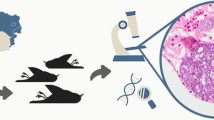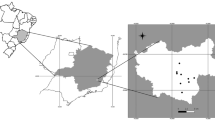Abstract
The palaeacanthocephalan Plagiorhynchus cylindraceus is a common intestinal parasite of passerine birds, which can also occur parenterally or in the intestinal tract of mammals, often as an invading species in many countries worldwide. In this survey, introduced hedgehogs (Erinaceus europaeus, n = 183) killed in New Zealand during a biocontrol campaign and conspecifics (n = 174) that had died in hedgehog rehabilitation centers in Germany and Britain were examined for this parasite. In New Zealand, P. cylindraceus is recorded for the first time here, in the vicinity of Auckland. In Europe, prevalences ranged from 4.2% up to 47.6%, while in New Zealand, only 1.6% (Auckland 7.9%). Most of the worms occurred inside the peritoneal cavity where they had partly degenerated. Since hedgehogs are seldom preyed upon in continental Europe but often become traffic victims, we hypothesize that the worms inside them, whether extra- or intraperitoneally, contribute to the abundance and persistence of the parasite by being ingested by scavenging birds. Accordingly, we consider P. cylindraceus as a “modern parasite” taking advantage of two aspects of global change: anthropogenic promoted transmission (road kills) and the transcontinental spread of infected intermediate and/or final hosts caused by humans.

Similar content being viewed by others
References
Amin O (1985) Classification. In: Nickol BB, Crompton DWT (eds) Biology of the Acanthocephala. Cambridge University Press, Cambridge, pp 27–72
Amin OM, Canaris AG, Kinsella JM (1999) A taxonomic reconsideration of the genus Plagiorhynchus s. lat. (Acanthocephala: Plagiorhynchidae), with descriptions of South African Plagiorhynchus (Prosthorynchus) cylindraceus from shorebirds and P. (P.) malayensis, and a key to the species of the subgenus Prosthorynchus. J Helm Soc Wash 66:123–132
Bezzel E, Obst J, Wickl KH (1976) Zur Ernährung und Nahrungswahl des Uhus (Bubo bubo). J Ornithol 117:210–238. doi:10.1007/BF01643587
Coady NR, Nickol BB (2000) Assessment of parenteral Plagiorhynchus cylindraceus (Acanthocephala) infections in shrews. Comp Parasitol 67:32–39
Connors VA, Nickol BB (1991) Effects of Plagiorhynchus cylindraceus (Acanthocephala) on the energy metabolism of adult starlings, Sturnus vulgaris. Parasitology 103:395–402
Dimelow EJ (1963) Observations on the feeding hedgehog (Erinaceus europaeus L.). Proc Zool Soc Lond 141:291–309
Dimitrova ZM (2009) Occurrence of cystacanths of Plagiorhynchus cylindraceus (Acanthocephala) in the terrestrial isopods Trachelipus squamuliger and Armadillidium vulgare (Oniscidea) in Bulgaria. Acta Parasitol 54:53–56. doi:10.2478/s11686-009-0003-9
Dimitrova ZM, Georgiev BB, Genov T (1999) New data on acanthocephalans of the genus Plagiorhynchus Lühe, 1911 (Palaeacanthocephala, Polymorphida, Plagiorhynchidae) from birds in Bulgaria. Helminthologia 36:261–267
Edelenyi B, Szabo I (1963) Parasitische Würmer in einheimischen Säugetieren. Ann Hist-Nat Mus Natl Hung 55:275–283
Ferrer D, Molina R, Castellà J, Kinsella JM (2004) Parasitic helminths in the digestive tract of six species of owls (Strigiformes) in Spain. Vet J 167:181–185. doi:10.1016/S1090-0233(03)00103-5
Golvan YJ (1994) Nomenclature of the Acanthocephala. Res Rev Parasitol 54:135–205
Holsbeek L, Rodts J, Muyldermans S (1999) Hedgehog and other animal traffic victims in Belgium: results of a countrywide survey. Lutra 42:111–119
Huijser MP, Bergers P (2000) The effect of roads and traffic on hedgehog (Erinaceus europaeus) populations. Biol Conserv 95:111–116. doi:10.1016/S0006-3207(00)00006-9
Jay M, Morad M, Bell A (2003) Biosecurity: a policy dilemma for New Zealand. Land Use Policy 20:121–129. doi:10.1016/S0264-8377(03)00008-5
Jones M (1928) An acanthocephalid, Plagiorhynchus formosus, from the chicken and robin. J Agric Res 36:773–775
Kennedy CR (2006) Ecology of the Acanthocephala. Cambridge University Press, Cambridge
Keymer IF, Gibson EA, Reynolds DJ (1991) Zoonoses and other findings in hedgehogs (Erinaceus europaeus): a survey of mortality and review of the literature. Vet Rec 128:245–249
Levri EP, Coppola BP (2004) First report of the acanthocephalan Plagiorhynchus cylindraceus in the terrestrial isopod Porcellio scaber. Comp Parasitol 71:90–91. doi:10.1654/4085
Martinez JA, Zuberogoitia I (2001) The response of the Eagle Owl (Bubo bubo) to an outbreak of the rabbit haemorrhagic disease. J Ornithol 142:204–211. doi:10.1007/BF01651788
Moore J (1983) Responses of an avian predator and its isopod prey to an acanthocephalan parasite. Ecology 64:1000–1015
Moore J, Bell DH (1983) Pathology (?) of Plagiorhynchus cylindraceus in the starling, Sturnus vulgaris. J Parasitol 69:387–390
Nickol BB (2003) Is postcyclic transmission under estimated as an epizootiological factor for acanthocephalans? Helminthologia 40:93–95
Nickol BB, Dappen GE (1982) Armadillidium vulgare (Isopoda) as an intermediate host of Plagiorhynchus cylindraceus (Acanthocephala) and isopod response to infection. J Parasitol 68:570–575
Pfäffle M, Petney T, Elgas M, Skuballa J, Taraschewski H (2009) Tick-induced blood loss leads to regenerative anaemia in the European hedgehog (Erinaceus europaeus). Parasitology 136:443–452
Reeve N (1994) Hedgehogs. T & AD Poyser (Natural History), London
Richards DT, Harris S, Lewis JW (1995) Epidemiological studies on intestinal helminth parasites of rural and urban red foxes (Vulpes vulpes) in the United Kingdom. Vet Parasitol 59:39–51. doi:10.1016/0304-4017(94)00736-V
Schicht-Tinbergen M (1989) Der Igel. Gustav Fischer Verlag, Jena
Schmidt GD, Kuntz RE (1966) New and little-known plagiorhynchid Acanthocephala from Taiwan and the Pescadores Islands. J Parasitol 52:520–527
Schmidt GD, Olsen O (1964) Life cycle and development of Prosthorhynchus formosus (van Cleave, 1918) Travassos, 1926, an acanthocephalan parasite of birds. J Parasitol 50:721–730
Skuballa J, Oehme R, Hartelt K, Petney T, Bücher T, Kimmig P, Taraschewski H (2007) European hedgehogs as hosts for Borrelia spp., Germany. Emerg Infect Dis 13:952–953
Smales LR (1988) Plagiorhynchus (Prosthorhynchus) cylindraceus (Goeze, 1782) Schmidt and Kuntz, 1966, from the Australian bandicoots Perameles gunnii Gray, 1838, and Isodoon obesulus (Shaw 1797). J Parasitol 74:1062–1064
Smales LR (2002) Plagiorhynchidae Meyer, 1931 (Acanthocephala) from Australasian birds and mammals, with descriptions of Plagiorhynchus (Plagiorhynchus) menurae (Johnston, 1912) and P. (P.) allisonae n. sp. Syst Parasitol 51:207–216. doi:10.1023/A:1014590530850
Smales LR (2003) An annotated checklist of the Australian Acanthocephala from mammalian and bird hosts. Rec S Aust Mus 36:59–82
Stevenson MA, Benard H, Bolger P, Morris RS (2005) Spatial epidemiology of the Asian honey bee mite (Varroa destructor) in the North Island of New Zealand. Prev Vet Med 71:241–252. doi:10.1016/j.prevetmed.2005.07.007
Taraschewski H (2000) Host-parasite interactions in Acanthocephala: a morphological approach. Adv Parasitol 46:1–179
Taraschewski H (2005) Acanthocephala (thorny or spiny-headed worms). In: Rhode K (ed) Marine parasitology. CSIRO Publishing, Collingwood Victoria, pp 116–121
Taraschewski H (2006) Hosts and parasites as aliens. J Helminthol 80:99–129. doi:10.1079/JOH2006364
Ward DF, Harris RJ, Stanley MC (2005) Human-mediated range expansion of Argentine ants Linepithema humile (Hymenoptera: Formicidae) in New Zealand. Sociobiology 45:1–7
Zhang ZQ (2000) Notes on Varroa destructor (Acari: Varroidae) parasitic on honeybees in New Zealand. Syst Appl Acarol Spec Publ 5:9–15
Acknowledgments
We wish to thank all people running hedgehog care centers in Germany and the UK, especially Heiko and Sigrun Goroncy (“Komittee für Igelschutz Hamburg”), Elisabeth Swoboda (“Igelkrankenhaus Stocksberg”), Manfred Kolb (“NaBu Berlin”), Dora Lambert (“Igelkreis Berlin”), Ulrike Pachzelt (“Igelinsel Mühlheim”), Dru Burdon (“Jersey Hedgehog Preservation Group”), Jill Carey (“Wildlife Rescue & Care Centre”), Iris Davidson, Dr. Wieland Beck (“Tierrettung München”), and all the others for their help in obtaining hedgehogs for dissection. Dr. Thomas Bücher provided support in dissecting hedgehogs in Karlsruhe.
We thank Mark Mitchell (Biosecurity, Auckland Regional Council) and Daniel Tompkins for sampling hedgehogs in New Zealand, as well as, Chris Jones and Dave Leathwick who provided two of us (JS, MP) with the opportunity to work at their facilities. Funding was provided by grants from the Landesgraduiertenförderung BW, the DAAD (German Academic Exchange Service), Krieger Foundation, and LBBW Foundation.
Author information
Authors and Affiliations
Corresponding author
Rights and permissions
About this article
Cite this article
Skuballa, J., Taraschewski, H., Petney, T.N. et al. The avian acanthocephalan Plagiorhynchus cylindraceus (Palaeacanthocephala) parasitizing the European hedgehog (Erinaceus europaeus) in Europe and New Zealand. Parasitol Res 106, 431–437 (2010). https://doi.org/10.1007/s00436-009-1681-9
Received:
Accepted:
Published:
Issue Date:
DOI: https://doi.org/10.1007/s00436-009-1681-9




